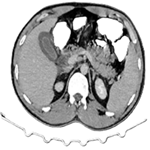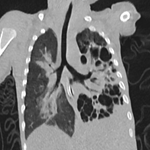Papillary thyroid carcinoma: an interesting case report
Shivali Kalode, Prajakta Ghewade, Prerna Tekulwar
Corresponding author: Shivali Kalode, Department of Pathology, Jawaharlal Nehru Medical College, Datta Meghe Institute of Higher Education and Research, Sawangi (Meghe), Wardha, Maharashtra, India 
Received: 17 Aug 2024 - Accepted: 05 Dec 2024 - Published: 06 Jan 2025
Domain: Laboratory medicine,General surgery,Surgical oncology
Keywords: Papillary, thyroid carcinoma, midline neck swelling, pseudo inclusions, case report
©Shivali Kalode et al. Pan African Medical Journal (ISSN: 1937-8688). This is an Open Access article distributed under the terms of the Creative Commons Attribution International 4.0 License (https://creativecommons.org/licenses/by/4.0/), which permits unrestricted use, distribution, and reproduction in any medium, provided the original work is properly cited.
Cite this article: Shivali Kalode et al. Papillary thyroid carcinoma: an interesting case report. Pan African Medical Journal. 2025;50:9. [doi: 10.11604/pamj.2025.50.9.45035]
Available online at: https://www.panafrican-med-journal.com//content/article/50/9/full
Papillary thyroid carcinoma: an interesting case report
&Corresponding author
The most common neoplasm is thyroid carcinoma, which can be categorized into papillary, follicular, medullary, undifferentiated, and anaplastic cancers based on histological features (ATC). Papillary thyroid carcinoma accounts for 70-80% of thyroid cancer cases and 1% of all malignancies. This disease entity is notorious for spreading to nearby lymph nodes, especially the cervical lymph nodes, and may manifest as a developing mass on the side of the neck. However, because of the palpable mass, these lesions usually become apparent and are detected quickly. We are reporting a case of an 18-year-old female, who presented with midline neck swelling. Papillary thyroid carcinoma was diagnosed on histopathology. The patient underwent total thyroidectomy with lymphadenectomy followed by therapeutic radioactive iodine ablation and received T4 suppression treatment. The patient was advised to have regular follow-ups with other systemic examinations. Due to various forms of thyroid carcinoma that raise suspicion of a possible familial cancer, early diagnosis, and thorough evaluation are required.
Papillary thyroid carcinoma (PTC) is the most common endocrine malignancy [1]. Of all malignancies, papillary thyroid carcinoma (PTC) accounts for 1% and 70-80% of thyroid cancers [2]. It is classified according to its histological characteristics into papillary cancer (PTC), follicular cancer (FTC), medullary cancer (MTC), and undifferentiated and anaplastic cancer (ATC) [3]. It may develop from thyroid follicular epithelial cells and para-follicular C cells [4]. These lesions usually have a palpable mass, which makes them easy to identify and diagnose. However, many investigations have provided a thorough description of early metastasis to neighboring lymph nodes, which may manifest as a solid or cystic cervical tumor [5]. Papillary thyroid cancer (PTC) comes in a variety of histological morphological forms, but the most common varieties are conventional [6]. Radiation therapy, gamma rays, radioactive iodine (I-131), benign thyroid illness, and a family history of thyroid cancer are risk factors [7]. Papillary thyroid carcinoma (PTC) is more common in women than in males, with two peak incidence periods in the third and seventh decades of life [8]. Due to its slower growth than other carcinomas, PTC has a better prognosis than others, and long-term survival may be anticipated even if distant metastases are detected [9].
Patient information: an 18-year-old female came to the Outpatient Department of Surgery at Sawangi (Meghe) Wardha with the chief complaint of midline neck swelling gradually developing over the previous four years. The patient has no significant medical history except for a history of trauma 4 years ago. Since then she started noticing swelling for which she did not take any medical treatment as the swelling was slow-growing and painless. According to the patient, the swelling has increased in size recently. There was no other record of either the constitutional symptoms or the prior trauma.
Clinical findings: on physical examination, all other findings were unremarkable except there was a midline neck mass of size 3x3cm (Figure 1).
Timeline of the current episode: midline neck swelling for 4 years, gradually increasing to the present size.
Diagnostic assessment: contrast enhanced computed tomography (CECT) of neck showed cystic formation at the midline of the neck measuring 3x2x1.5 cm (Figure 2). Based on this report the diagnosis of thyroid carcinoma was considered. Following this report, the total thyroidectomy was done and the specimen was sent to the histopathology section in the department of pathology. Grossly, the total thyroidectomy specimen measured 6x4x3cm. A well-defined greyish area on the cut section was soft to firm in consistency measuring 3x2.5x1.8 identified (Figure 3). Microscopic examination at 40X high power view showed a papillary growth pattern with optically clear chromatin and nuclear pseudo inclusions (Figure 4).
Diagnosis: histopathological findings confirmed the diagnosis of papillary thyroid carcinoma.
Therapeutic interventions: the patient underwent total thyroidectomy with lymphadenectomy followed by therapeutic radioactive iodine ablation and received T4 suppression treatment.
Follow-up and outcome of interventions: the patient was advised for regular follow-up with other systemic examinations to rule out recurrence and metastasis.
Patient perspective: the patient was satisfied with the diagnosis and treatment.
Informed consent: the patient gave written informed consent so that this case report and any related photos could be published.
Papillary thyroid carcinoma, or papillary thyroid carcinoma, is the most prevalent endocrine cancer; it accounts for around 85% of all well-differentiated thyroid malignancies generated from follicular cells with a about 93% 10-year survival rate [1]. Radiation, growth factors, and genetic changes are some of the reasons linked to the development of this tumor. Age, the size of the tumor, and histological characteristics such as lymph node invasion, extracapsular extension, extrathyroidal extension, distant metastasis, and histological variants are all closely correlated with the prognosis of this tumor [2]. According to recent research, the incidence of metastatic illness at the time of diagnosis is close to 50%. There may be almost total cystic degeneration in the affected lymph nodes, making it difficult to distinguish between benign cervical cysts and malignant metastatic illness [5]. In 20% of cases, the tumor is multicentric inside the thyroid gland upon microscopic examination. In 35% of cases, papillary cancer cells' cytoplasm contains round, laminated calcium ions known as psammoma bodies. Unique cytologic and histologic characteristics of papillary carcinoma, such as indentations in the nuclear membrane, cytoplasmic inclusions in the nucleus, and fibrous capsule, enable pathological diagnosis [8].
The most common form of thyroid cancer is papillary thyroid carcinoma, but it is essential to evaluate thyroid neoplasms in all their forms because of rare forms that vary in morphological aspects, such as areas with cribriform architecture, and follicular, papillary, trabecular, solid, and spindle cell growth patterns with morular areas. In this case, we were able to demonstrate papillary arrangement with optical clear chromatin and nuclear pseudo inclusions which helped to detect and treat papillary thyroid carcinoma. Therefore, solid excrescences and punctate echogenic foci should be specifically identified if a cystic lesion is observed in the thyroid gland to detect potential malignant etiologies such as papillary carcinomas [8].
The authors declare no competing interests.
Shivali Kalode: concept and design, analysis or interpretation of data, manuscript drafting, responsible for every part of the work. Prajakta Ghewade and Prerna Tekulwar: acquisition, analysis, or interpretation of data, critical review, supervised the work. All the authors have read and agreed to the final manuscript.
Figure 1: midline neck swelling
Figure 2: contrast enhanced computed tomography- cystic formation at the midline of the neck
Figure 3: gross image-cut-section of an excised specimen of thyroidectomy
Figure 4: microscopic examination [H&E,40X]- papillary growth pattern with optically clear chromatin and nuclear pseudo inclusions
- Coca-Pelaz A, Shah JP, Hernandez-Prera JC, Ghossein RA, Rodrigo JP, Hartl DM et al. Papillary Thyroid Cancer-Aggressive Variants and Impact on Management: A Narrative Review. Adv Ther. 2020 Jul;37(7):3112-3128. PubMed | Google Scholar
- Gonzalez-Gonzalez R, Bologna-Molina R, Carreon-Burciaga RG, Gómezpalacio-Gastelum M, Molina-Frechero N, Salazar-Rodríguez S. Papillary thyroid carcinoma: differential diagnosis and prognostic values of its different variants: review of the literature. ISRN Oncol. 2011;2011:915925. PubMed | Google Scholar
- Jimenez-Baez MV, Chávez HMM, Hernández HLB, Luis SJ. Papillary thyroid carcinoma: case presentation and literature report. IJFCM. 2020.
- Brehar AC, Terzea DC, Ioachim DL, Procopiuc C, Brehar FM, Bulgăr AC et al. Cribriform-morular variant of papillary thyroid carcinoma at pediatric age - case report and review of the literature. Rom J Morphol Embryol. 2016;57(2):531-7. PubMed | Google Scholar
- Schwaiger K, Koeninger F, Wimbauer J, Heinrich K, Gala-Kokalj A, Wechselberger G. Occult papillary thyroid cancer presenting as cystic metastasis of the lateral neck: a case report. Medicine (Baltimore). 2019 Jul;98(30):e16659. PubMed | Google Scholar
- Yang J, Gong R, Ma Y, Gao J, Li Z, Zhu J et al. Case Report: A New Entity: Multiple Differentiated Variant of Papillary Thyroid Carcinoma With Advanced Clinical Behavior. Front Endocrinol (Lausanne). 2021 Apr 7:12:654638. PubMed | Google Scholar
- Kim K, Cho SW, Park YJ, Lee KE, Lee DW, Park SK. Association between Iodine Intake, Thyroid Function, and Papillary Thyroid Cancer: A Case-Control Study. Endocrinol Metab (Seoul) . 2021 Aug;36(4):790-799. PubMed | Google Scholar
- Chougule Sonesh R, Desai Sanjay M. Cystic papillary carcinoma of thyroid gland: a rare case. Indian J Otolaryngol Head Neck Surg. 2007 Dec;59(4):380-1. PubMed | Google Scholar
- Kosugi Y, Ohba S, Matsumoto F, Sasai K. Case of papillary thyroid cancer presenting with an inoperable cervical mass successfully treated with high-dose radiation therapy. BMJ Case Rep. 2021 Nov 30;14(11):e246084. PubMed | Google Scholar
















